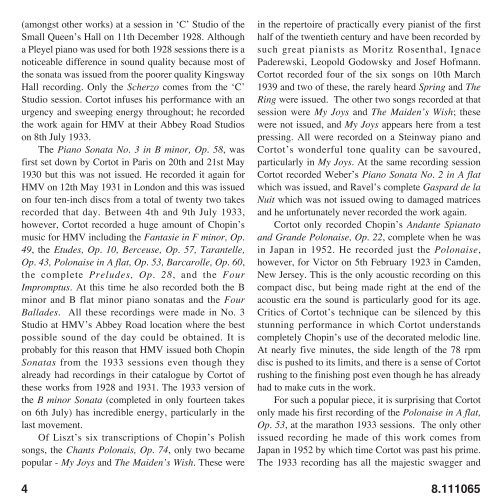CHOPIN Piano Sonatas Nos. 2 and 3 Polonaises Alfred Cortot
CHOPIN Piano Sonatas Nos. 2 and 3 Polonaises Alfred Cortot
CHOPIN Piano Sonatas Nos. 2 and 3 Polonaises Alfred Cortot
You also want an ePaper? Increase the reach of your titles
YUMPU automatically turns print PDFs into web optimized ePapers that Google loves.
(amongst other works) at a session in ‘C’ Studio of the<br />
Small Queen’s Hall on 11th December 1928. Although<br />
a Pleyel piano was used for both 1928 sessions there is a<br />
noticeable difference in sound quality because most of<br />
the sonata was issued from the poorer quality Kingsway<br />
Hall recording. Only the Scherzo comes from the ‘C’<br />
Studio session. <strong>Cortot</strong> infuses his performance with an<br />
urgency <strong>and</strong> sweeping energy throughout; he recorded<br />
the work again for HMV at their Abbey Road Studios<br />
on 8th July 1933.<br />
The <strong>Piano</strong> Sonata No. 3 in B minor, Op. 58, was<br />
first set down by <strong>Cortot</strong> in Paris on 20th <strong>and</strong> 21st May<br />
1930 but this was not issued. He recorded it again for<br />
HMV on 12th May 1931 in London <strong>and</strong> this was issued<br />
on four ten-inch discs from a total of twenty two takes<br />
recorded that day. Between 4th <strong>and</strong> 9th July 1933,<br />
however, <strong>Cortot</strong> recorded a huge amount of Chopin’s<br />
music for HMV including the Fantasie in F minor, Op.<br />
49, the Etudes, Op. 10, Berceuse, Op. 57, Tarantelle,<br />
Op. 43, Polonaise in A flat, Op. 53, Barcarolle, Op. 60,<br />
the complete Preludes, Op. 28, <strong>and</strong> the Four<br />
Impromptus. At this time he also recorded both the B<br />
minor <strong>and</strong> B flat minor piano sonatas <strong>and</strong> the Four<br />
Ballades. All these recordings were made in No. 3<br />
Studio at HMV’s Abbey Road location where the best<br />
possible sound of the day could be obtained. It is<br />
probably for this reason that HMV issued both Chopin<br />
<strong>Sonatas</strong> from the 1933 sessions even though they<br />
already had recordings in their catalogue by <strong>Cortot</strong> of<br />
these works from 1928 <strong>and</strong> 1931. The 1933 version of<br />
the B minor Sonata (completed in only fourteen takes<br />
on 6th July) has incredible energy, particularly in the<br />
last movement.<br />
Of Liszt’s six transcriptions of Chopin’s Polish<br />
songs, the Chants Polonais, Op. 74, only two became<br />
popular - My Joys <strong>and</strong> The Maiden’s Wish. These were<br />
4<br />
in the repertoire of practically every pianist of the first<br />
half of the twentieth century <strong>and</strong> have been recorded by<br />
such great pianists as Moritz Rosenthal, Ignace<br />
Paderewski, Leopold Godowsky <strong>and</strong> Josef Hofmann.<br />
<strong>Cortot</strong> recorded four of the six songs on 10th March<br />
1939 <strong>and</strong> two of these, the rarely heard Spring <strong>and</strong> The<br />
Ring were issued. The other two songs recorded at that<br />
session were My Joys <strong>and</strong> The Maiden’s Wish; these<br />
were not issued, <strong>and</strong> My Joys appears here from a test<br />
pressing. All were recorded on a Steinway piano <strong>and</strong><br />
<strong>Cortot</strong>’s wonderful tone quality can be savoured,<br />
particularly in My Joys. At the same recording session<br />
<strong>Cortot</strong> recorded Weber’s <strong>Piano</strong> Sonata No. 2 in A flat<br />
which was issued, <strong>and</strong> Ravel’s complete Gaspard de la<br />
Nuit which was not issued owing to damaged matrices<br />
<strong>and</strong> he unfortunately never recorded the work again.<br />
<strong>Cortot</strong> only recorded Chopin’s Andante Spianato<br />
<strong>and</strong> Gr<strong>and</strong>e Polonaise, Op. 22, complete when he was<br />
in Japan in 1952. He recorded just the Polonaise,<br />
however, for Victor on 5th February 1923 in Camden,<br />
New Jersey. This is the only acoustic recording on this<br />
compact disc, but being made right at the end of the<br />
acoustic era the sound is particularly good for its age.<br />
Critics of <strong>Cortot</strong>’s technique can be silenced by this<br />
stunning performance in which <strong>Cortot</strong> underst<strong>and</strong>s<br />
completely Chopin’s use of the decorated melodic line.<br />
At nearly five minutes, the side length of the 78 rpm<br />
disc is pushed to its limits, <strong>and</strong> there is a sense of <strong>Cortot</strong><br />
rushing to the finishing post even though he has already<br />
had to make cuts in the work.<br />
For such a popular piece, it is surprising that <strong>Cortot</strong><br />
only made his first recording of the Polonaise in A flat,<br />
Op. 53, at the marathon 1933 sessions. The only other<br />
issued recording he made of this work comes from<br />
Japan in 1952 by which time <strong>Cortot</strong> was past his prime.<br />
The 1933 recording has all the majestic swagger <strong>and</strong><br />
8.111065






